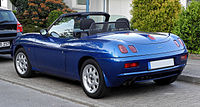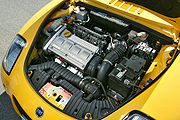Fiat Barchetta
| Fiat | |
|---|---|
|
Fiat Barchetta (1995-2003)
|
|
| Barchetta | |
| Production period: | 1995-2005 |
| Class : | Compact class |
| Body versions : | Cabriolet |
| Engines: |
Petrol engine : 1.8 liters (96 kW) |
| Length: | 3888-3916 mm |
| Width: | 1640 mm |
| Height: | 1265 mm |
| Wheelbase : | 2275 mm |
| Empty weight : | 1135 kg |
| Previous model | Fiat X1 / 9 |
The Fiat Barchetta [ barˈketːa ] (Type 183) is a roadster that was built by the Italian automobile manufacturer Fiat from early 1995 to mid-2005. The model was named after the Italian word for "small boat" or "boat" . The open, two-door two-seater was based on the platform of the first-generation Fiat Punto . It is considered to be the answer to the success of Mazda's MX-5 Roadster .
design
The design comes from Andreas Zapatinas , who also drew other convertibles (including the BMW Z8 ). The car was mostly assembled by hand at the bodybuilder Maggiora in Chivasso . After the bankruptcy of Maggiora, Fiat moved production to the Mirafiori plant.
Characteristic of the body are frameless side windows, door handles embedded in the door and a hood that can be completely retracted under a cover. The latter can be operated mechanically and is equipped with a plastic rear window. The trunk holds three beverage crates with a volume of 165 liters; When the top is closed, the top compartment can also be used as additional storage space. A hardtop with a heated rear window was available as an option. The cockpit with the characteristic round instruments ties in with the sports car tradition of Fiat. The Fiat Barchetta was one of the first mass-produced vehicles with clear glass headlights.
engine
The 1.8-liter four-cylinder naturally aspirated engine has an output of 96 kW (131 hp) and a maximum torque of 164 Nm at 4300 rpm. The same engine was used in the Fiat Coupé from 1996 . According to the manufacturer, the Barchetta reaches a top speed of 200 km / h, accelerates from 0-100 km / h in 8.9 seconds and consumes 8.4 l / 100 km (combined) according to 99/100 / EC. It complies with the Euro 3 emissions standard.
The engine comes from the “Fiat Pratola Serra modular engines” family, named after the FMA Fabbrica Motori Automobilistici production plant in Pratola Serra (this location joined Fiat with Alfa Romeo in 1987). This engine is available in a similar form in numerous other Fiat and Lancia Lybra models. It is structurally similar to the new generation of Alfa Romeo Twin-Spark engines. During the production time of the Fiat Barchetta, different variants of this engine were used, which differ in constructional details and also meet different emission standards.
From the start of production until 1998, it had an aluminum intake manifold and the air mass meter was mounted directly on the air filter. From May 1998 there was an intake manifold made of plastic of variable length and the air mass meter was located directly on the intake manifold. These engines have the logo VIS for variable intake system on the valve cover.
From summer 2000, an engine with an electronically controlled throttle valve was installed in order to meet the Euro 3 emissions standard. The engine versions did not differ nominally in their performance.
Common to all engine versions was an adjustment device for the intake camshaft (called phase variator at Fiat), which produced high torque at low speed (due to low valve overlap) with high torque and thus high output at high speeds (due to large valve overlap). The adjusting piston on the camshaft was hydraulically actuated by engine oil, depending on the speed and load, and returned to its starting position by a helical spring. This spring was initially the cause of defects in this adjustment device. The camshaft then stayed in the high speed position. This became noticeable in a very hard, diesel-like running noise when idling and at low speeds, which has given the phase variator the name "diesel part" in Barchetta circles. The spring, which deteriorated over time, was changed several times in the series, the last version fixed the problem permanently.
Facelift
The Fiat Barchetta was built in various, partly limited special editions (1998: Limited Edition; 1999: Limited Edition LE99; 2000: Lido, Riviera, Amalfi; 2001: Naxos, Milano; 2004: Adria), which are distinguished by their special coloring (body, Interior fittings, soft top), leather seats and other equipment variants.
Every now and then there were necessary adjustments, e.g. B. the introduction of a third brake light in May 2000 or changes to the engine due to more stringent requirements for exhaust emissions.
In mid-2003 the front and rear of the Barchetta were redesigned. In contrast, almost nothing changed in terms of technology and motorization during the entire production period.
End of production
The production of the Fiat Barchetta, the 1995 Convertible of the Year was chosen, ended in June 2005 after ten years of production. A total of 57,521 vehicles were produced, around half of which were registered in Germany .
Technical details
| Engine: | Four-cylinder in-line engine (water-cooled) |
| Mounting position: | Front engine transverse |
| Displacement : | 1747 cc |
| Bore × stroke: | 82.0 x 82.7 mm |
| Valves per cylinder: | 4 (inlet valves adjustable by variable camshaft control) |
| Valve control: | 2 overhead camshafts (toothed belt drive) |
| Maximum power: | 96 kW (131 PS) at 6300 rpm |
| Max. Torque . | 164 Nm at 4300 rpm |
| Power transmission: | 5-speed gearbox (center shift), front-wheel drive |
| Landing gear: | front wishbones with MacPherson struts , rear parallel swing arms with coil springs and shock absorbers, stabilizer front and rear, rack and pinion steering |
| Brake: | Hydraulic dual-circuit brake with brake booster, disc brakes (internally ventilated at the front) |
| Construction: | Two-seat convertible with two doors |
| Wheelbase: | 2275 mm |
| Track width front / rear: | 1412/1407 mm |
| Tires: | 195/55 R 15 H |
| Length × width × height: | 3916 × 1640 × 1265 mm |
| Trunk volume: | 165 l |
| Empty weight (including driver): | 1135 kg |
| Max. Load: | 165 kg |
| Tank volume: | 50 l |
| Average consumption: | 8.5 l / 100 km |
| Fuel: | great |
| Emission standard: | Euro 2; Euro 3 |
| CO 2 emissions : | 181 g / km |
| Top speed: | 200 km / h |
| Acceleration, 0-100 km / h: | 8.9 s |
literature
- Werner Schruf in auto, motor und sport , issue 9/1995, ISSN 0005-0806 .
- Auto catalog 2004 , Vereinigte Motor-Verlage, Stuttgart 2003.
Web links
Individual evidence
- ↑ Heiko Jahn: 2003 model year . On April 14, 2006 at barchetta-lexikon.de, accessed on June 3, 2019



